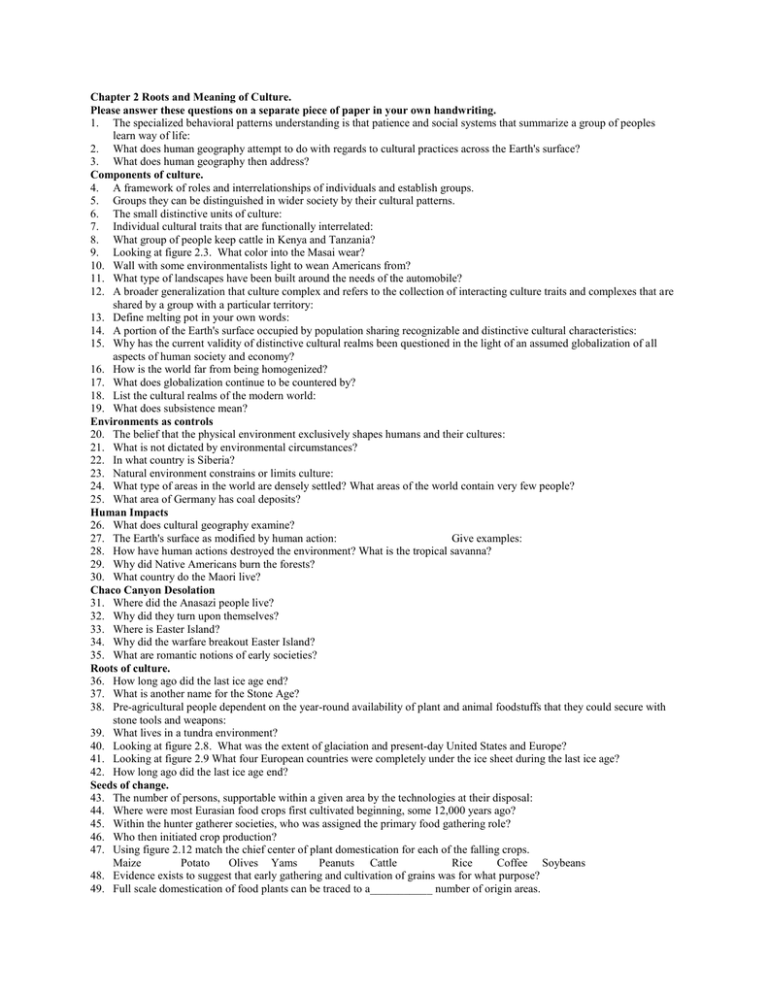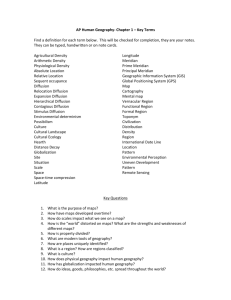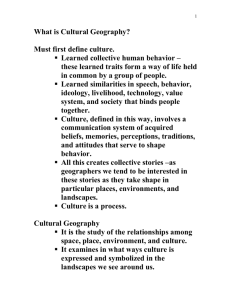Chapter 2 Roots and Meaning of Culture. Please answer these
advertisement

Chapter 2 Roots and Meaning of Culture. Please answer these questions on a separate piece of paper in your own handwriting. 1. The specialized behavioral patterns understanding is that patience and social systems that summarize a group of peoples learn way of life: 2. What does human geography attempt to do with regards to cultural practices across the Earth's surface? 3. What does human geography then address? Components of culture. 4. A framework of roles and interrelationships of individuals and establish groups. 5. Groups they can be distinguished in wider society by their cultural patterns. 6. The small distinctive units of culture: 7. Individual cultural traits that are functionally interrelated: 8. What group of people keep cattle in Kenya and Tanzania? 9. Looking at figure 2.3. What color into the Masai wear? 10. Wall with some environmentalists light to wean Americans from? 11. What type of landscapes have been built around the needs of the automobile? 12. A broader generalization that culture complex and refers to the collection of interacting culture traits and complexes that are shared by a group with a particular territory: 13. Define melting pot in your own words: 14. A portion of the Earth's surface occupied by population sharing recognizable and distinctive cultural characteristics: 15. Why has the current validity of distinctive cultural realms been questioned in the light of an assumed globalization of all aspects of human society and economy? 16. How is the world far from being homogenized? 17. What does globalization continue to be countered by? 18. List the cultural realms of the modern world: 19. What does subsistence mean? Environments as controls 20. The belief that the physical environment exclusively shapes humans and their cultures: 21. What is not dictated by environmental circumstances? 22. In what country is Siberia? 23. Natural environment constrains or limits culture: 24. What type of areas in the world are densely settled? What areas of the world contain very few people? 25. What area of Germany has coal deposits? Human Impacts 26. What does cultural geography examine? 27. The Earth's surface as modified by human action: Give examples: 28. How have human actions destroyed the environment? What is the tropical savanna? 29. Why did Native Americans burn the forests? 30. What country do the Maori live? Chaco Canyon Desolation 31. Where did the Anasazi people live? 32. Why did they turn upon themselves? 33. Where is Easter Island? 34. Why did the warfare breakout Easter Island? 35. What are romantic notions of early societies? Roots of culture. 36. How long ago did the last ice age end? 37. What is another name for the Stone Age? 38. Pre-agricultural people dependent on the year-round availability of plant and animal foodstuffs that they could secure with stone tools and weapons: 39. What lives in a tundra environment? 40. Looking at figure 2.8. What was the extent of glaciation and present-day United States and Europe? 41. Looking at figure 2.9 What four European countries were completely under the ice sheet during the last ice age? 42. How long ago did the last ice age end? Seeds of change. 43. The number of persons, supportable within a given area by the technologies at their disposal: 44. Where were most Eurasian food crops first cultivated beginning, some 12,000 years ago? 45. Within the hunter gatherer societies, who was assigned the primary food gathering role? 46. Who then initiated crop production? 47. Using figure 2.12 match the chief center of plant domestication for each of the falling crops. Maize Potato Olives Yams Peanuts Cattle Rice Coffee Soybeans 48. Evidence exists to suggest that early gathering and cultivation of grains was for what purpose? 49. Full scale domestication of food plants can be traced to a___________ number of origin areas. 50. Domestication focused on plant species selected for their capability of providing large quantities of what? 51. What fertile and productive areas did agricultural innovation most likely occurred? 52. While adapting wild plant stock to agricultural purposes, how did human cultivators adapt too? 53. They developed labor specializations and created more formalized and expansive__________. 54. Who were the victors when farmers and hunter gatherers came in contact? Neolithic innovations 55. What is another name for the Neolithic age? 56. How did people who lived in the Neolithic age, acquire food? 57. In what ways did they purposefully restructure their environment? 58. What do they use metal to make? 59. As people gathered together in larger communities, what became more formalized? 60. Religions responsive to those concerns developed rituals appropriate to what? 61. Occupations became increasingly_______________. Is geography destiny? Top of page 46. Be prepared to write an essay on this topic 62. Who wrote guns germs and steel? 63. According to him, where was there an abundance of plants and animals suited for domestication? 64. Given examples of these plants and animals. 65. According to dine and population growth, agricultural productivity and inventive minds led to_____. 66. Because of their geographical disadvantage, inhabitants of other continents quickly found themselves subdued and_______. Culture hearths 67. Centers of innovation and invention from which clusters of key cultural traits and elements move to exert an influence on surrounding regions. 68. According to figure 2.15. What does B.C.E stand for? 69. Looking at the map on page 47. What do we call Mesoamerica today? 70. What is a word for spatial spread? 71. Sharing of technologies, organizational structures and cultural traits that is so evident among widely separated societies in the modern world united by communication and transportation: Read the structure of culture. There are no questions. Culture Change 72. In what way is the recurring theme of cultural geography change? 73. What is often associated with the Industrial Revolution? 74. Changes to a culture that result from ideas created within the social group itself and adopted by the culture: 75. What type of societies characteristically are not very innovative? 76. What percentage of the world's population than 10,000 B.C. were hunter gatherers? 77. What percentage of the world's population were hunter gatherers by 1500? 78. In modern societies innovative changes become common expected and____________. 79. The spatial implication is that larger urban centers of advanced technologies tend to be centers of___________. Diffusion 80. The process by which an area or innovation is transmitted from one individual or group to another across space. 81. When people move to a new area and take their culture with them. 82. Information about an innovation may spread throughout a society. 83. Where has Islam diffused? 84. The incidents of adoption under expansion diffusion is represented by what shape of the curve? 85. When adoption of an innovation spreads from an area where it is practiced to a neighboring area reflecting distance decay: 86. The pattern of transferring ideas first between the larger places or prominent people and only later to smaller or less important points or people: 87. what example of this is used in the book? 88. What has encouraged and facilitated the globalization of culture? 89. What example of relocation diffusion does the book use? 90. Why did the innovations of the Industrial Revolution diffuse, easily from England to North America? 91. Why is innovation sometimes rejected? Acculturation and cultural modification 92. When a culture group to undergoes major modification by adopting characteristics of another dominant cultural group. 93. Given example from your book. 94. It is estimated that in no more than ______ of the cultural items of any society are traceable to innovations created by its members. 95. Any condition that hinders either the flow of information or movement of people and prevents the acceptance of innovation: 96. Because of the ___________ of distance, the farther to areas are from each other, the less likely is interaction to occur. 97. List three barriers to cultural diffusion. 98. What do the Taliban and other Mideast fundamentalist groups reject them? 99. The process of diffusion of old and new cultural practices: 100. How is foreign food and example of the above question?





